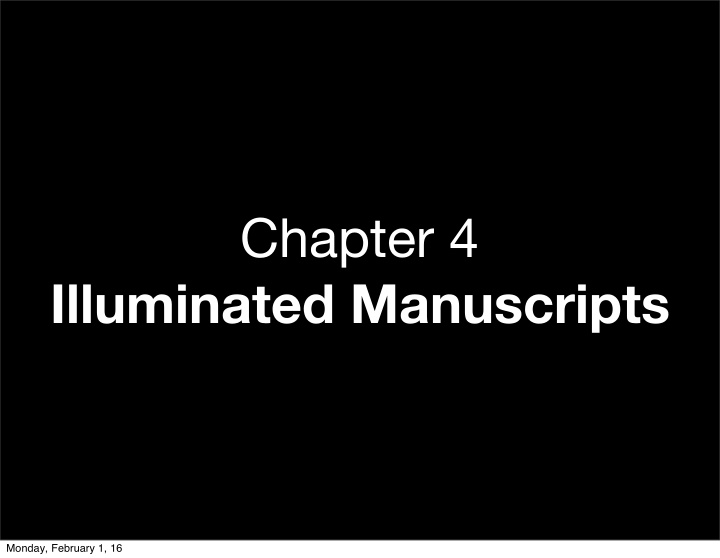



Chapter 4 Illuminated Manuscripts Monday, February 1, 16
Beautiful detail of a goldleaf illuminated initial with St. Stephen from a choir book created in Prague around 1405 CE Monday, February 1, 16
The term “Illuminated Manuscript” is used to describe all decorated and illustrated hand-rendered books produced from the late Roman Empire (BCE 330) until the time printed books replaced manuscripts in Europe around 1450 CE. Monday, February 1, 16
Scriptorium: The writing room of a monastery Monday, February 1, 16
Scrittori: The head of the Scriptorium; a highly educated scholar fluent in Greek and Latin. His job was to oversee the design and production of the manuscripts Monday, February 1, 16
Copisti: A production letterer; a scribe who spent hours a day copying page after page in a specific, trained lettering style Monday, February 1, 16
Illuminator: An artist responsible for the ornamentation and imagery that gave visual support to the text Monday, February 1, 16
Colophon: (a term still used today) An inscription, usually at the end of the book, containing facts about its production. Monday, February 1, 16
The scribes in the medieval monasteries are also credited with the invention of musical notation Monday, February 1, 16
The Vatican Vergil , the earliest surviving manuscript from the late antique and early Christian era, created in the late fourth century or early fifth century CE THE VATICAN VERGIL IS AN EXCELLENT EXAMPLE OF THE CLASSICAL STYLE Monday, February 1, 16
Uncials were so named because they were written between two guidelines that were one uncia apart. An uncia was a Roman Inch. Monday, February 1, 16
Uncials from the Gospel of Saint Matthew, eighth century CE Rounded strokes were made with the pen held in a straight horizontal position. Monday, February 1, 16
Majuscules: CAPITAL OR UPPER CASE LETTERS Miniscules: small or lower case letters Monday, February 1, 16
Half uncials, sixth century CE This specimen, written in a monastery in southern Italy, demonstrates the emergence of ascenders and descenders. Monday, February 1, 16
Monday, February 1, 16
Monday, February 1, 16
The Book of Durrow, the man is a symbol of Matthew, 680 CE. As flat as a cubist painting and constructed from simple geometric forms. Monday, February 1, 16
Detail from The Book of Kells. 794-806 CE Amidst intricate spirals and lacertines, the artist has drawn 13 human heads, 2 cats, 2 mice calmly watching 2 other mice tug at a wafer, and an otter holding a salmon. Monday, February 1, 16
The Lindesfarne Gospels, carpet page facing the opening of Saint Matthew, c. 698 CE. A mathematical grid buried under swirling lacertine birds and quadrupeds brings structure to the textured areas. A red, contoured cross with white circular “buttons” brings stability to the design. Monday, February 1, 16
The Book of Durrow, opening page, The Gospel of St. Mark, 680 CE. Linked into a ligature, the I and the N become an aesthetic form of interlaced threads and coiling spirals. This page shows the use of DIMINUENDO Monday, February 1, 16
The Book of Kells, text page with ornamental initials, c. 794-806 CE. The originality of the hundreds of illustrated initials is shown by the variety of forms in the six initials on this one page. WHAT ELSE DO YOU NOTICE ABOUT THIS IMAGE? Monday, February 1, 16
A significant design innovation in Celtic manuscripts was to leave spaces between the words , allowing for easier reading Monday, February 1, 16
Charlemagne madated that master copies of important religious texts be prepared by skilled scribes and illuminators. He created a standardized writing style which is known as Caroline miniscules Monday, February 1, 16
Caroline miniscules from the Alcuin Bible, ninth century CE. An economy of execution and good legibility characterize this new writing style. Monday, February 1, 16
Commemorative labyrinth from Pope Gregory’s Commentary on Job, 945 CE. Starting in the center on the top line, the inscription reads down, left, and right, establishing a labyrinth of letterforms. Monday, February 1, 16
The Four Horsemen of the Apocalypse, from the Beatus of Fernando and Sancha, 1047 CE. War, Famine, Pestilence and Death ride forth across bands of thick, bright color to unleash their terror upon the world. Monday, February 1, 16
The fourth angel from the Beatus of Fernando and Sancha, 1047 CE. Revelation 8:12 tells, “the fourth angel sounded and the third part of the sun was smitten, and the third part of the moon...” Monday, February 1, 16
During the 1200s came the rise of the University and with it, an enormously expanding market for books Monday, February 1, 16
Exemplars: Master copies of books that could be lent for a fee in order to produce additional copies Monday, February 1, 16
Monday, February 1, 16
The 1200s also saw a major innovation in book design: The Word Concordance or INDEX Monday, February 1, 16
This manuscript from 1265 CE distinctly shows the page format and guidelines followed by the scribes and illuminators. Monday, February 1, 16
Monday, February 1, 16
The Washington Haggadah, c. 1478 CE by artist and scribe Joel ben Simeon. Masterful Hebrew calligraphy, accompanied by gold initials. The word was supreme, pictures played a supporting role. Monday, February 1, 16
Islamic manuscript early 1700s CE Monday, February 1, 16
Calendar pages from the Limbourg brothers book for the duc de Berry show remarkable observational and painting skill. Monday, February 1, 16
In the early 1400s the most popular book in Europe was the private, devotional Book of Hours. Traditionally, a Book of Hours contains religious texts for each hour of the day, prayers and calendars listing the days of important saints. Monday, February 1, 16
Vade Mecum: (to go with me) “Something I carry with me that brings me comfort” Monday, February 1, 16
The best preserved chained library in Britain is the Hereford Cathedral Library Monday, February 1, 16
http://youtu.be/LGLD_Bv43vw? list=PLS12qnwBb76eebqgyzPILb-svMm0_t-0n Monday, February 1, 16
Recommend
More recommend